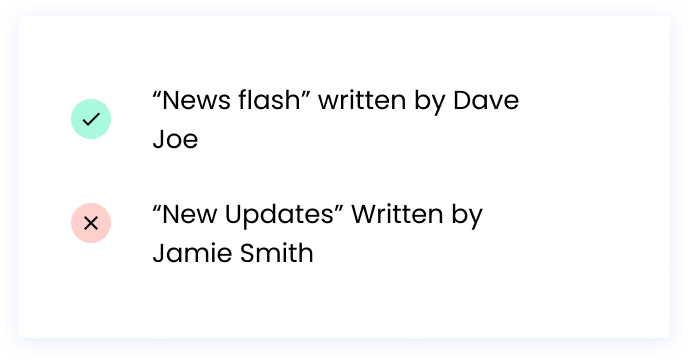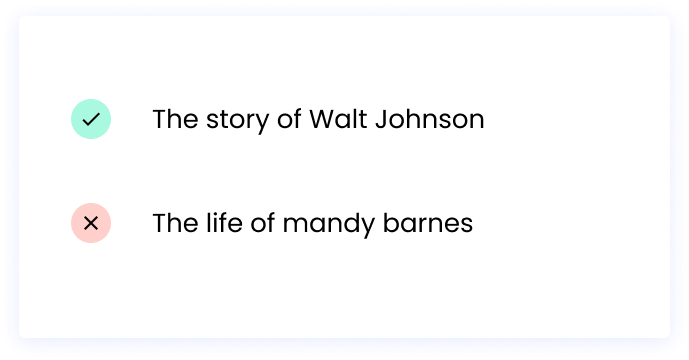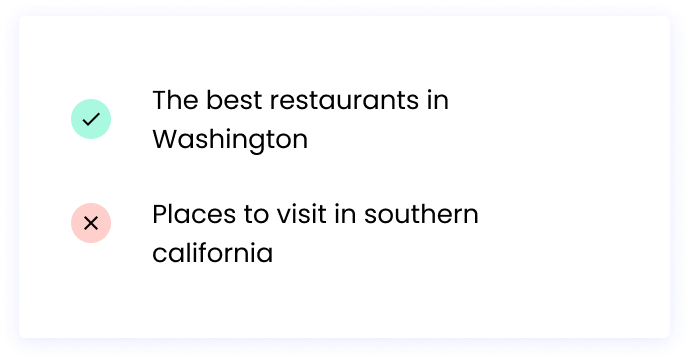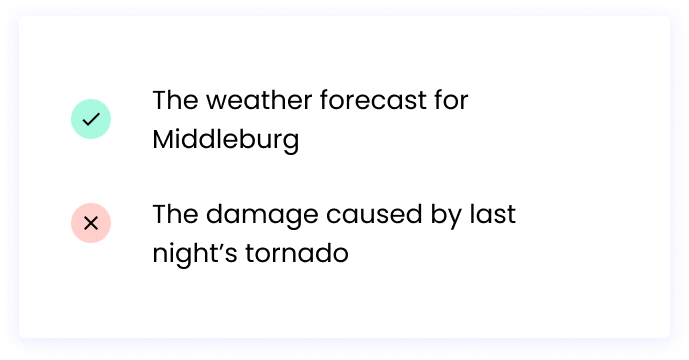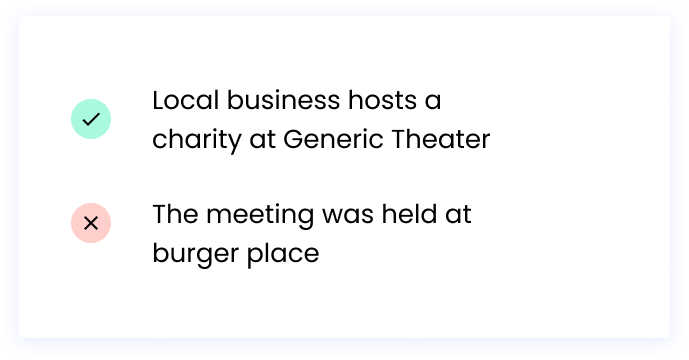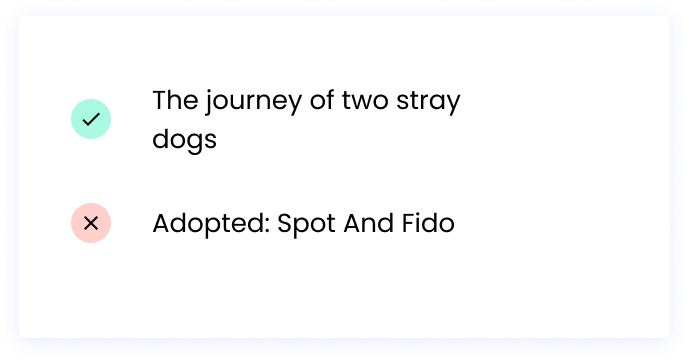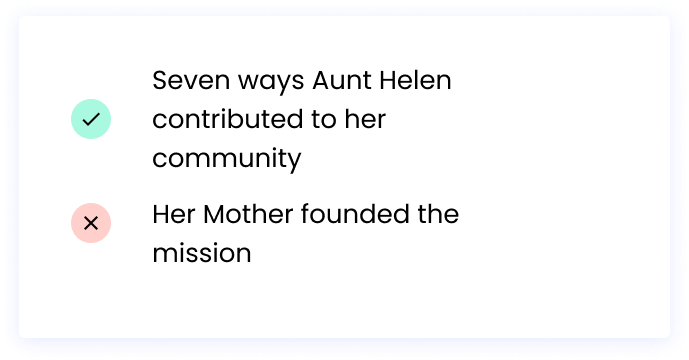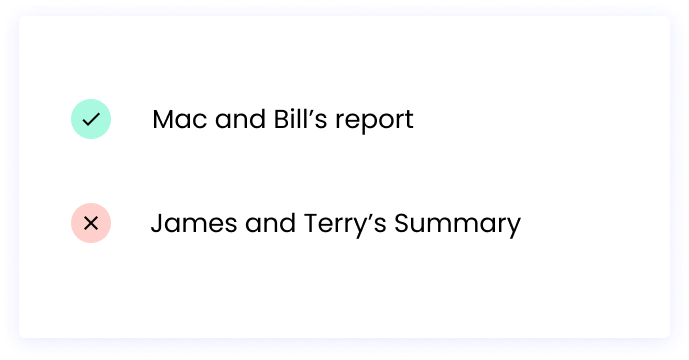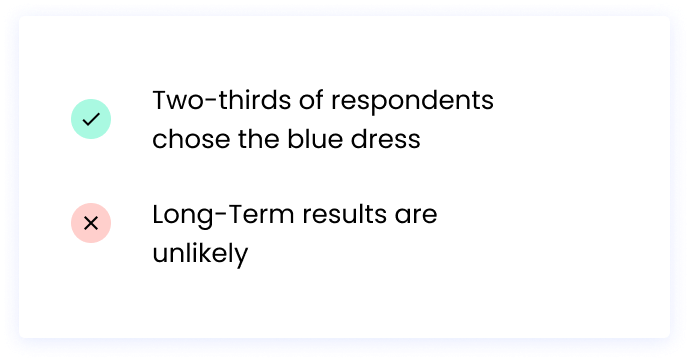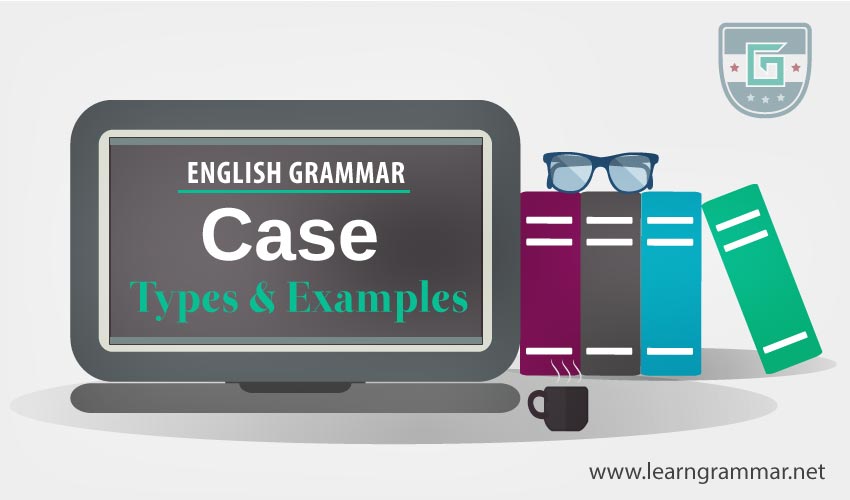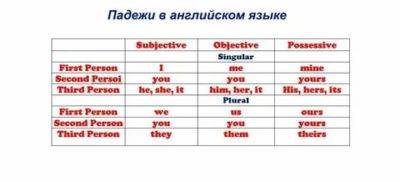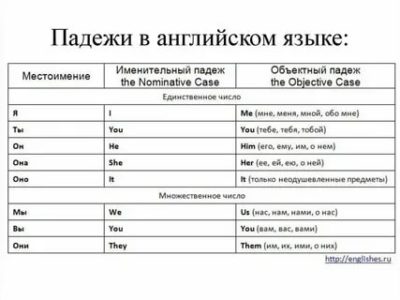With every title and subheading comes the need to figure out how it should be capitalized.
Depending on your style guidelines, the answer will likely be either title case or, more likely, sentence case. Sentence case is one of the most common capitalization styles out there. You’ll likely run into making the decision when writing a paper, essay, or blog post that includes a heading and subheading.
But what’s the difference between sentence case and title case, and does it matter which style you use?
In this post, we’ll answer all of these questions and give you examples of how to correctly use sentence case in your writing. We’ll also share our favorite free tools for automatically checking and converting your text into sentence case.
What is sentence case?
Sentence case, also known as down style or reference style, is a capitalization style. For this post, we’ll refer to it as its most common name: sentence case. This capitalization style is common in both the academic and professional worlds.
You’ve likely seen sentence case used in newspaper headlines and subheadlines this isn’t the only place you’ll find it. Sentence case can be part of a report, webpage, article, or another piece of work. Keep in mind that in addition to titles, sentence case rules can apply to subtitles, headings, and subheadings.
When you use sentence case, you capitalize just the first letter of the first word in the title. The rest of the words and letters in the title should not be capitalized, unless they’re proper nouns. True to its name, you’re essentially writing a sentence case title the same way you would a regular sentence.
However, some special circumstances will require capitalization in different parts of the sentence. For instance, like we mentioned, a proper noun would need to be uppercase no matter where it falls in the header.
What’s the difference between sentence case and title case?
Different writing styleguides and different situations call for either sentence or title case. But what’s the difference?
With sentence case, as mentioned above, you’ll need to capitalize the first letter of the first word in the title. The rest of the words aren’t capitalized, except for proper nouns.
However, title case is nearly the opposite. The first letter of each word in the title should be capitalized with title case. Like sentence case, this rule does have exceptions. Prepositions, articles, and other small words should be lowercase —his means words like “a,” “but,” “and,” or “of.” But in general, most of the words in title case will be capitalized.
Examples of sentence case style
Sentence case is easy to get the hang of with a little bit of practice. To get started, here are some examples you can reference.
Example 1:
Why: The first word after a colon should not be capitalized. Proper nouns still need to be capitalized in sentence case.
Example 2:
Why: Titles of reports do not need to be capitalized in sentence case.
Example 3:
Why: Titles of written works should not be capitalized in sentence case.
Example 4:
Why: Names should still be capitalized in sentence case.
Example 5:
Why: Countries, states, cities, etc., are all proper nouns and need to be written in uppercase.
Example 6:
Why: The first letter in sentence case must be capitalized.
Example 7:
Why: The names of places like restaurants and buildings are considered proper nouns. They should be capitalized.
Example 8:
Why: Small words, articles, and prepositions should not be capitalized in sentence case.
Example 9:
Why: Family relationship references (such as aunt, uncle, and cousin)should only be capitalized if they’re used as a proper noun. Otherwise, they should be lowercase with the rest of the common nouns in a sentence case title.
Example 10:
Why: This subhead in a report needs to follow sentence case guidelines.
Example 11:
Why: Names must be capitalized, but that doesn’t mean the rest of the sentence should follow title case guidelines.
Example 12:
Why: This one is a bit tricky. Typically, you want to lowercase all letters after the first one in sentence case unless it’s a proper noun. However, various styleguides have different rules for hyphenated words like the ones above. Check your specific guide for capitalization rules in this case.
Best free online sentence case checkers
These tools can all be used to proofread your work by checking for the correct use of sentence case.
If you miss the capitalization of a proper noun or forget to lowercase a word, these three online checkers will automatically fix it for you — and they’re free to use!
1. Convert Case
This tool is free to use and simple to navigate. Just drop your text in the box and watch your title get converted to sentence case at the click of a button. Once your work has been checked and converted to proper sentence case, if applicable, you can download or copy the new text to your clipboard.
2. Case Converter
Case Converter is an easy-to-use, web-based converter tool. To check your work, pop your text into the box and press one of four options: “UPPER CASE,” “lower case,” “Proper Case,” and “Sentence case.” You’ll want to select “Sentence case” here, but note that “Proper Case” shouldn’t be mistaken for title case. With proper case, all of the first letters of a word are capitalized, even articles, short words, and prepositions.
3. HTML Cleaner
HTML Cleaner lets you check and convert text to sentence case as well as other capitalization styles like “uppercase,” “snake_case,” and even “RaNdOM.” This site is useful for more than just sentence case checking. It’s great for anyone working on a website because it lets you copy text without the messy code that can disrupt your formatting. The tool lets you work in CSS, JS, and of course, HTML. But you don’t need to mess with code to use it. Just use it to check your sentence case titles for free!
At the end of the day, you’ll want to refer to your writing styleguide to see where you need to use sentence case and title case. Follow the guidelines, practice writing in sentence case, and don’t be afraid to use a case checker to verify your work.
Looking to use sentence case consistently in headlines and headings? Try Writer! Start a free trial today and customize your styleguide.
More resources
Updated on October 01, 2019
Sentence case is the conventional way of using capital letters in a sentence or capitalizing only the first word and any proper nouns.
In most newspapers in the U.S. and in virtually all publications in the U.K., sentence case, also known as down style and reference style, is the standard form for headlines.
Examples and Observations
- «The 100-year-old scientist who pushed the FDA to ban artificial trans fat.»
- «Barack Obama flies to thank troops who killed Bin Laden.»
- «FBI investigating Cardinals’ alleged hacking of Astros’ computer system.»
- AP Style: Headlines
«Only the first word and proper nouns are capitalized…» - APA Style: Sentence Style in Reference Lists
«In titles of books and articles in reference lists, capitalize only the first word, the first word after a colon or em dash, and proper nouns. Do not capitalize the second word of a hyphenated compound.» - «Librarians and bibliographers work with minimal capitals [i.e., sentence case], . . . yet [other options] are well established in literary tradition. For many people there’s virtue in using [sentence case] in lists and bibliographies, but using one of the other options for titles quoted in the course of a written discussion.»
- «In major companies, the problem of consistency may be largely unreconcilable. The public relations department has to use a ‘down style’ because it is writing for newspapers, but department heads insist on capitalizing the names of titles and departments…»
Sources
- The Washington Post, June 16, 2015
- The Guardian [U.K.], May 7, 2011
- Democrat and Chronicle [Rochester, N.Y.], June 16, 2015
- The Associated Press Stylebook: 2013, edited by Darrell Christian, Sally Jacobsen, and David Minthorn. The Associated Press, 2013
- (Publication Manual of the American Psychological Association, 6th ed. American Psychological Association, 2010
- Pam Peters, The Cambridge Guide to English Usage. Cambridge University Press, 2004
- Donald Bush and Charles P. Campbell, How to Edit Technical Documents. Oryx Press, 1995
In English grammar, you don’t talk about case particularly often. Unlike some languages such as German, which inflects nouns, articles, adjectives, and pronouns into four distinct cases, English grammar has only three cases, all three of which are inflected in personal pronouns and one of which is inflected in all nouns.
Grammatical Case
In modern English grammar, there are just three main cases, so here’s a short explanation of them and how they’re inflected in nouns and pronouns.
|
Pronouns |
Nouns |
|
|
Nominative (subjective) case |
I (first-person singular) You (second-person singular) He/ she/ they (third-person singular) |
No inflection |
|
Accusative (objective) case |
Me (first-person singular) You (second-person singular) Him/ he/ them (third-person singular) |
No inflection |
|
Genitive case |
Mine (first-person singular) Yours (second-person singular) His/ hers/ theirs (third-person singular) |
-’s, -s’ |
As you can see, there are only four broad areas for case in English (three areas in pronouns and one in nouns). Now, you probably want to know more about inflection and case conceptually.
Case Grammar
In grammar, case is a kind of inflection.
Inflection is how a word changes to suit a particular grammatical function.
Case is one such grammatical function. Other inflections include gender (not present in English nouns as a class), number (present in English), and more.
The case of a word changes based on its role in the sentence (e.g., whether it acts, is acted upon, or possesses something).
For example, if a noun is the subject of the sentence, it might change case. In English, this would happen if you use the personal pronoun for yourself (I/me/mine).
❌ You wouldn’t say:
Mine is having a nice day.
✅ You would say:
I am having a nice day.
This is because you use the personal pronoun “I” when you are the subject of the sentence. In English grammar, there are three cases for personal pronouns, which correspond to personal pronouns as the subject, personal pronouns as the object, and personal pronouns as possessing.
Additionally, there is one case for any noun if it possesses something.

Case Types
There aren’t that many types of cases in English grammar, so it shouldn’t be too taxing to review them all more in-depth.
Case in Modern English Personal Pronouns
Here is a more complete chart of cases in modern English personal pronouns.
|
Singular |
Plural |
||
|
Nominative |
First-person |
I |
We |
|
Second-person |
You |
You |
|
|
Third-person |
He, She, It, They |
They |
|
|
Accusative |
First-person |
Me |
Us |
|
Second-person |
You |
You |
|
|
Third-person |
Him, Her, It, Them |
Them |
|
|
Genitive |
First-person |
My/Mine |
Our/Ours |
|
Second-person |
Your/Yours |
Your/Yours |
|
|
Third-person |
His, Her/Hers, Its, Their/Theirs |
Their/Theirs |
In the chart, you’ll notice that the genetive pronouns often split. This distinction is between the independent genetive and the dependent genetive.
The independent genitive can stand on its. “That is mine.”
The dependent genitive requires an object. “That is my friend.”
An independent genitive is independent because it can be independent of other words. A dependent genitive is dependent because it depends on other words.
You might have noticed that English lacks a robust system of cases for second-person pronouns. While first-person and third-person pronouns have appropriately different plural cases, second-person pronouns use “you” repeatedly. In English, you might remedy this by saying “you all,” the contracted «y’all,» or “you folks” in the plural nominative or plural accusative. However, to further clarify the genitive for a plural second-person pronoun turns up odd constructions like, “You all’s» or «Y’all’s.» Hmm!
The Case of “Who”
There is one notable instance where case changes with generic pronouns.
Generic pronouns refer to non-specific things.
“Who” is a personal generic pronoun while “what” and “which” are non-personal generic pronouns.
While “what” and “which” do not change in the nominative or accusative (and do not have genitives), “who” changes.
| Case | «Who» | In a sentence… |
|
Nominative |
Who |
Who goes there? |
|
Accusative |
Whom |
I’m speaking to whom? |
|
Genetive |
Whose |
Whose mittens are these? |
This just about covers case in pronouns.
You might be wondering: what about myself, yourself, herself, and those other “self” pronouns? These are called reflexive pronouns. Reflexive pronouns indicate that the subject has acted upon itself.
“She hit herself with a branch.”
However, whether “reflexive” is a case unto itself is debatable. One argument against “reflexive” as a case in English is that reflexive pronouns are more for emphasis or clarity rather than being strictly necessary. As a fact, “She hit her” is perfectly grammatical, even if “her” refers to “she.” It’s just unclear.
Case in Modern English Nouns
If you remember the initial chart, there is only one use of case in the Modern English noun, and that is the genitive -’s and -s’.
Genitive means possessive!
Let’s say the noun is “women.” To put “women” in the genitive case, you’d simply add a -’s.
Women’s rights.
-s’ is used if the word already ends in an s. This happens often for plural nouns. For example, say you want to put the plural of “friend” in the genitive case.
That is our friends’ backyard.
Whether you put an -’s or a -s’ at the end of a proper noun depends on the style you are using. For instance, the Chicago Manual of Style favors -‘s. However, both are correct:
Sometimes, a style has you look at what follows the -s! For instance, the Chicago Manual of Style wants you to avoid three successive s. It would have you write «Silas’s horse» but «Silas’ saddle.»
Fun fact: Other languages include prominent instrumental and vocative cases. These cases indicate what someone uses to complete an action and who is being addressed, respectively. Even more of a fun fact, English has something like the vocative case, although it uses a comma called the vocative comma («Hello, friend»).
Case Examples
If you want some practice, write a few example sentences based on the cases in these prompts.
-
Write a sentence using a third-person plural dependent genitive.
-
Write a sentence using the second-person plural accusative.
-
Write a sentence using the first-person singular nominative.
Here are three sample responses. The specified case is highlighted.
-
We grabbed their scarves.
-
They like you folks.
-
I know that.

Case Explanation
You might want an explanation of how English can only have three cases — and in such a limited capacity — while other languages require a complex inflective system. This is because English is an analytic language.
An analytic language uses word order, auxiliary verbs, and prepositions to indicate what is happening in a sentence.
In other words, English has its own complexities unrelated to case. Languages with many cases are called synthetic languages.
Synthetic languages use a large number of inflections to indicate what is happening in a sentence.
For instance, in Latin, word order doesn’t matter. Case tells you all you need to know. On the other hand, English requires word order for a sentence like:
Bill hit Paul.
Here, because Bill appears first, we know that Bill did the hitting and Paul was hit. Prepositions can also help explain things in English.
Bill smiled at Paul.
Here, the word “at” helps us know that Bill did the smiling and Paul was smiled at.
Interestingly, English was not always this way. While Modern English is an analytic language, Old English was a synthetic language.
Linguistic Analysis of Case
Without going too deep into linguistic analysis, it’s worth going back in time and taking a peek at how Old English differs from Modern English in terms of case.
Old English had four cases for its nouns: nominative, accusative, genitive, and dative. You’ll recognize three of them from Modern English pronouns. The last one is dative.
The dative case is used for an indirect object.
In the following sentence, the man would be written in the dative case, if Modern English had such a case.
John gave a cup of coffee to the man.
This is because John (the subject) gives the cup of coffee (the direct object) to the man (indirect object).
Additionally, Old English had gender as well as strong and weak adjective declensions. Old English bears much in common with German, actually! Hopefully, though, this insight into Old English also gives you some context for Modern English case.
Case — Key Takeaways
- In grammar, case is a kind of inflection.
- Modern English grammar only has three cases: nominative, accusative, and genitive.
- Nominative is for subjects, accusative for objects, and genitive for possession.
- Modern English pronouns use all three of these cases.
- Modern English nouns as a whole only have one special case — genitive — for possession (e.g., Chris’s or the boy’s).
Case: Definition, Types & Examples
Cases indicate the grammatical functions of nouns and pronouns according to their relation with rest of the words in a sentence.
In modern English, there are only three kinds of cases.
- Subjective Case
- Objective Case
- Possessive Case
Subjective Case (Nominative Case)
When a noun or a pronoun works as a subject in the sentence, a subjective case appears.
Example:
- Louis works in the management.
- He works very hard for the company.
- I love to watch movies in my free time.
- Reading is a very good habit.
Objective Case
When a noun or a pronoun works as an object in the sentence, an objective case appears.
Example:
- Robert does not eat burgers.
- He loves pizza.
- Robert told me that.
- Alex follows Robert.
Possessive Case
Possessive cases indicate a relationship of possession or belongingness between two nouns or a noun and a pronoun.
Example:
- Robin’s house is near the river. (Two nouns related in the basis of possession.)
- His brother lives in the city. (A pronoun and a noun)
- My family does not approve this.
- Shaun’s wife has passed away.
Note: The pronoun changes its form in different cases.
| Subjective | Objective | Possessive |
| I We You He She They It Who |
Me Us You Him Her Them It Whom |
My, mine Our, ours Your, yours His Her, hers Their, theirs Its Whose |
There is another kind of case. It is called the vocative case. This case is similar to the subjective case in term of spelling. The vocative case indicates a person being addressed directly by his/her name. This name is separated by a comma.
Example:
- Robert, could you please open the door?
- You, watch out the bus.
- Listen to me, Russel.
- How are you, Susan?
What are the two cases in English. Cases in English: case systems, the use of prepositional structures
And numbers that serve to connect words in a sentence. But their cases in English, which are variants of the same word (word form), still exist. Fortunately, there are only 3 of them: objective, subjective and possessive. Let ‘s talk about each one of them. C «mon.
Subject and object cases in English
To understand the concept of the object case, we will have to go back in time and recall a little the school course of the Russian language. We all remember that the subject is the word in the nominative case. As for the rest of the nouns and pronouns in the sentence, they will most often be additions.
In English, everything follows the same principle. A pronoun or a noun or is a subject (subject), or addition (object). Recall that the subject answers the question «who?» and what»? (nominative).
It is not hard to guess that subject will stand in subjective case, additions — In objective case.
A man saw a dog near a building.
There are 3 nouns in this sentence: a Mon, dog and to building.
In the first place, as always, is subordinatefor which is used subjective case in English. It is followed by addition a dog, which, respectively, is in object case. As you can see from the example, the form of the noun has not changed.
Object case for pronouns
With nouns, everything is simple — they do not change their form for both cases (subjective and objective). But pronouns have their own special form in the case when they are not in the place of the subject:
I saw him, and he saw me.
Possessive in English
If everything is more or less clear with the subject and object cases, since they correspond to the case forms of the Russian language, then we do not have the possessive case. For questions of belonging (“whose?”, “Whose?”, “Whose?”, “Whose?”), We have an adjective. And in English, this function is performed by the category of case of nouns and pronouns.
However, for nouns and pronouns, the possessive function will be different.
To indicate belonging in nouns, use «»s”. Moreover, the ending is added to the noun to which something belongs.
This is my mother »s bag
This is my mother’s bag.
If noun ends in hissing or «s«, Then just add apostrophe :
I «ll take my parents» car.
I’ll take my parents’ car.
Should be distinguished possessive «»s«On contractions of the verb «is«-» «s».
I John ‘s new blazer.
Whose new blazer? John, therefore John «s — possessive the noun John.
I think, John’s right.
What is John doing? Is right, therefore John «s — reduction from John is right.
Now let’s look at some special uses of the possessive ending «»s«:
- If the plural of a noun ends in not on «s«, Then we use the full variant of the possessive ending — apostrophe + «s«: Mouse — mice. The main character is mice «s King. — The main character is the King of Mice.
- In English, there are compound nouns that consist of several words. They are usually hyphenated. to such words «»s«Is added after the very last word: We all waited for The-Boy-Who-Lived »s speech. “We were all waiting for the speech of the boy who survived.
The possessive case of inanimate nouns is formed by means of the preposition “of«, Not the endings» «s«(The headquarter of the company). But there are exceptions for:
- Planets — Jupiter «s size.
- Newspapers and organizations — Times «s editor, UNESCO »s operation.
- Distance and time — ten meter «s height, a minute «s business.
- Seasons and months — summer «s sadness, July «s here.
- Cities and countries — Minsk »s Main Square, Russian »s elite force.
Words like nature, ship, nation, country, because,water, City, boat, ocean and
Source: https://tues.ru/kakie-dva-padezha-v-angliiskom-yazyke-padezhi-v-angliiskom-yazyke-sistemy/
Cases in English. Cases of nouns in English. Possessive case is not used
And numbers that serve to connect words in a sentence. But their cases in English, which are variants of the same word (word form), still exist. Fortunately, there are only 3 of them: objective, subjective and possessive. Let ‘s talk about each one of them. C «mon.
The use of prepositions in English
What I love about English prepositions is the ability to completely change the meaning of the main word with the help of one such small word. It was «look at», but now:
• «look for»
• «to have an opinion» (look upon)
• «look after»
• «forgive» (look over)
• «look to».
Juggling with English pretexts is aerobatics. If you learn this art, you will enrich your vocabulary and generate a buzz of approval with your speech.
Many English learners take pretexts with some arrogance, believing that it is like a student repeating the English alphabet at night. Underestimated. But in vain.
Yes, prepositions are considered official, they do not answer any questions, but they allow you to get different meanings from the same verb, form cases (yes, the same ones that are in Russian) and do other interesting things. There is only one problem: there are a LOT of prepositions in English.
But this does not mean that you need to learn all of them right here and now. It is enough only to know the main ones, as well as to understand the division into groups.
Let’s not waste time on the fact that prepositions are simple monosyllabic, polysyllabic, consisting of several words, blah blah blah. Let’s get down to business and provide not only tables of prepositions in English, but also illustrative examples in pictures. We will also consider the use of prepositions with examples.
1. Prepositions of place and direction (spatial)
It is better to see once than to read the synopsis 100 times:
2. Temporary prepositions
Let’s consider the most basic ones: about, after, at, during, for, in, on, till, within.
| about | about (about, about) | It’s about 6 pm |
| after | after | Summer comes after spring. (Summer comes after spring) |
| at | в | Let’s meet at 10 am |
| During | for | She was sleeping during the whole lesson. (She slept throughout the lesson) |
| for | for | He laughed for 5 minutes. (He laughed for 5 minutes) |
| in | via | I’ll be home in 10 minutes. (I’ll be home in 10 minutes) |
| on | by | I usually go shopping on Fridays. (I usually go shopping on Fridays) |
| to | to | I won’t go shopping till Sunday. (I won’t go shopping until Sunday) |
| Within | within, for | You must do it within a month. (You have to do it in a month) |
because of — because;
on account of — due to, due to;
thanks to — thanks;
in accordance with — according to, in accordance with.
As you can see, the same preposition can be in different groups (for example, in or on are both temporal and spatial). Moreover, if you open any dictionary (well, at least the same Yandex) and select any preposition, you will be surprised at the number of meanings. Let’s say the most commonly used English preposition to can have 13 values (do not be lazy, take a look).
Let’s talk a little about the nuances before inviting you to go into battle the «tests» section, where the first linguistic tests for knowing prepositions await you.
SINGING OFFERS!
Yes, yes, to sing along or even read out. When you get acquainted with the basic excuses, try yourself in the role of Eminem, Timati, or any rapper you like. Not enough ideas for the text yet? Mix up prepositions! Knowing small and remote prepositions is very cool. Check it out by watching the video and feel like a rising rap star.
ENGLISH PROSPECTS AND RUSSIAN PADES. We remember the second class.
• Genitive case (who? What?) — preposition of
Show me the plan of the house.
• Dative case (to whom? What?) — preposition to
Give it to me.
• Accusative case (who? What?) — no preposition
Give me a pen.
• Instrumental case (by whom? What?) — preposition With
She was cutting the letter with scissors.
• Prepositional case (about whom? About what?) — preposition about
Don’t speak about me.
PLACE OFFER IN OFFER
Any excuse, know your place!
• In general, the preposition is supposed to be put BEFORE a noun or pronoun (if the noun has an article or a definition, then you cannot break it)
Put the book on the table.
Give it to me.
The shop is behind the green house.
You must do it with in two months.
• In interrogative sentences (which start with what, where, etc.), the preposition is placed at the end:
What city do you live in?
Who are you waiting for?
• The rest of the cases are associated with the use of prepositions in subordinate clauses, passive constructions. All this will be more relevant to study in the «Syntax» section.
• It is very useful to learn the signs, where the preposition has already merged with a certain noun. Useful in everyday communication.
| by | By mistake By accident By chance By the way By bus / train / car Day by day Step by step | by mistake by accident by accident by the way by bus / train / car day after day step by step |
| for | For a walk / dance / drink / swim For breakfast / dinner | go for a walk / dance / drink / swim for breakfast / lunch |
| in | In fact In case In future In love In time In the morning / evening / afternoon | in fact, in the event in the future, in love in the morning / evening / afternoon |
| on | On television On holiday / a trip On foot | on TV on vacation / on foot |
| at | At home / work At night At present | at home / at work at night |
By the way, about the last three pretexts. They won a special place under the sun and formed their own caste — prepositions of place. Why it is necessary to collect a dossier on them no less than on a counterintelligence agent, an article specially devoted to them will tell and prove.
Simple valuable advice: since it is impossible to learn ALL prepositions at the first time of learning (and it is not necessary), when you write out the next new verb from the dictionary, mark yourself at least 2 options with different prepositions.
For example:
Put — put
Put on — to place a bet on (smb., Sm.)
Put across — to deceive
When it becomes a habit, you will one day be happy to find that the use of the verb is masterful: in different meanings for the situation. This will brighten your speech and save you from any pauses and «mmm», «eee», «aaa». In the meantime, the problem exists, then you need to solve it, starting with passing a thematic test on prepositions.
Have you sorted the prepositions on the shelves in your head? There are spots even on the Sun, so we suggest once again (which is not at all superfluous) to go through the pretexts by watching a video tutorial on the topic. After watching and several years of practice, you can safely assign yourself the honorary title of «guru».
Source: https://iloveenglish.ru/theory/anglijskaya_grammatika/predlog
General and possessive. Possessive nouns in English: meaning and education
We are accustomed to the fact that in Russian it is enough to inflect a word by case, thereby forming the context we need.
But what to do in such a situation with English, where there is practically no case system? First, here the syntactic meaning of a word is always determined by its place in the sentence.
And secondly, as many as three case categories are distinguished, but not all of them play a really significant role. In today’s material, we will consider how cases are formed in English, what parts of speech they correspond to, and what function they perform.
First, let’s find out what this section of grammar is. Case is a term denoting the syntactic role of a sentence member or the semantic meaning of a word in a phrase. In simple terms, the case determines the dependence of one word on another. The subject, addition, definition is expressed in the corresponding case in the sentence.
Russian grammar allows you to apply this term to a noun, pronoun, adjective, participle, numeral. But in English, cases can be found only in two parts of speech: a noun and a pronoun. Moreover, they bring more changes to the class of pronouns. Consider the English case system.
Cases in English
Since English uses a fixed word order, the role of cases is somewhat crumpled and not always actively expressed. But this is not a reason not to consider their construction and use.
On the contrary, for confident use of the language, you need to be able to work with any grammatical constructions, and the category of case is no exception. Let us ask ourselves a question: how many cases are there in English? Officially, there are three, but only two are singled out.
We will break down a three-tier classification.
Subjective category
Translated into Russian, this is the most common nominative case, which emphasizes that a noun / pronoun acts as a subject. This grammatical construction does not differ in anything remarkable: both nouns and pronouns are used in it in their usual dictionary form.
- She is my best friend —Itmybestfriend.
- Peteris a clever boy —Peter —smartboy.
- Children read the book —Childrenreada book.
The second case in English is much more peculiar.
Objective category
This is the so-called indirect case. In this case, nouns / pronouns are not actors / objects, but objects of these actions. Accordingly, in the proposal, this construction is associated with the role of the complement.
When translated into Russian, depending on the context, words can be put in the genitive, dative, proposed and accusative cases. It is noteworthy that nouns still do not change their construction, and most personal pronouns get a completely new form.
| Subject | Object | Transformation |
| I | Me | I ⟶ me, me |
| you | you | you, you ⟶ you, you, you, you |
| He | Him | he ⟶ him, him |
| She | Here | she ⟶ her, her |
| It | It | it ⟶ him, him, this, this, her, her (inanimate.) |
| We | Us | we ⟶ us, us |
| They | Them | they ⟶ them, us |
The pronoun who (who?) Is also subject to changes, which turns into whom (whom? To whom?).
- Give me a pen, please —Giveto me,pleasepen.
- I told them the truth —Ясказалthemthe truth.
- The boy bought a ball —Youngsterboughtball.
In the case of nouns, these two case categories are combined into one common case, because in their composition there are still no changes, and the syntactic role is to a greater extent always determined by the location of the word. A separate and most specific case is the third group.
Source: https://spainproject.ru/shifer/obshchii-i-prityazhatelnyi-padezh-prityazhatelnyi-padezh-sushchestvitelnyh-v-angliiskom-yazyke-znachenie-i-ob/
Cases of nouns in English. Cases in English. Special uses’ s
The simplicity of the English language is that, unlike other languages, English nouns do not change by case. More precisely, in English there are two whole cases (common and possessive), but everything is much simpler than what we are used to when studying 6 Russian cases in elementary school. Therefore, the case of a noun in English is very simple to determine.
Common case
In this case, English nouns do not change and no endings or suffixes are added to them. In this case, the noun can play absolutely diverse roles in the sentence (subject, direct, indirect and prepositional addition, definition). Regardless of how the noun is used, it will look the same.
He reads a book.
She goes to the school.
The plate is on the backgammon.
The only difficulty that can arise when using the common case is using the correct prepositions. When a noun acts as a subject or a direct object, they are not required.
In other cases, you sometimes have to think about what pretext should be put in this or that case.
That is, if in Russian the connection of nouns with other words is expressed by changing the endings (in different cases — in different ways), then in English when declining a noun the endings are always the same, and the connection with other words is conveyed using different prepositions.
Dative (To whom? What? Where?) Is conveyed in English using the preposition to:
Emma goes to school every day. — Emma goes to school every day.
Give it to me… — Give me that.
Instrumental case depending on the situation, it can be expressed using with, by and some other prepositions.
I wrote this text with the pen… — I wrote this text with a pen.
How With me. — Come with me.
Possessive nouns in English
The possessive case of a noun in English can cause some difficulties in learning at first, but if you understand the basic rules from the very beginning, then everything will seem very simple in the future.
feature: the possessive case is formed using a simple construction «‘s», which is added to each «owner». That is, to the one who owns something.
You already know that possessive pronouns express the belonging of something to certain persons — me, you, him, her, and so on. Here the situation is somewhat different — we know a specific person. That is, my mother’s house will be translated as “my mother’s house«.
Pretty simple, isn’t it? In fact, this is what we are used to. Genitive… Who’s (whose) house? Mom.
For example:
cat’s fur — cat hair
women’s cars — women car
If you read textbooks or articles on the Internet, then in most cases you will see an indication that the possessive case in English using the construction ‘s only possible for animate nouns. The inanimate form the genitive case only with the help of the preposition “of«.
However, if you dig deeper and ask the English speakers themselves, they do not see much crime in what you say, for example, “the book’s cover«, but not «the cover of the book«.
There is an opinion that people for whom English is not native often overdo it with the formation of the possessive case with the help of a preposition and, conversely, too rarely use the possessive form. ‘s.
According to some sources, the prohibition on the formation of the genitive case with the help ‘s inanimate nouns are no longer supported by native speakers. However, in England this is stricter than in the United States. But in any case, you should not bother with this if you are just starting to learn a language. Over time, listening to often English speech, you will figure out what’s what. And asking the native speakers themselves is not so difficult.
Here are some examples of the genitive «‘s» in inanimate nouns:
Everest’s peak — the top of Everest
Earth’s climate — Earth’s climate
Moscow’s life — life in Moscow
England’s football team — England national football team
The Times’ article — article «The Times»
today’s schedule — schedule for today
the summer’s heat — summer heat
the car’s engine — car engine
But keep in mind that sometimes you can do without adding ‘s… This happens when the first word is the definition. For example, in the last two words, you can also say: “summer heat» and «the car engine«.
By the way, in addition to adding «s» and an apostrophe to a word, the genitive case can also be obtained using the preposition «of», as you might have guessed. And this applies not only to inanimate objects.
The possessive case of nouns in English has another peculiarity. If the word is in the plural and has the ending «s», then instead of ‘s only apostrophe is added ‘.
So we will be able to distinguish when writing, how many persons are in question, and it is more convenient to pronounce without doubling. However, if you look at words in the singular ending in «s», then this rule does not apply to them.
Even a word like boss (with two “s” at the end!) Gets another “s” to boot, only this time with an apostrophe.
Finally, I will give examples that will allow you to understand how to use correctly ‘s in the formation of the possessive case with different types of nouns.
The case of a noun in English, which has any differences in education, in fact, only one. You need to know him. You probably noticed that there were no difficulties in this lesson. Therefore, I hope that you have mastered the material and now you can easily apply it in practice.
1. The concept of a grammatical category in English.
The grammatical category is one of the basic concepts of any language, including English. A grammatical category is a union of two or more grammatical forms opposed or correlated by grammatical meaning. This grammatical meaning is assigned to a given set of forms (paradigm). Outside of constant formal indicators, the grammatical category does not exist.
The grammatical category includes at least two opposed forms, but more of them are possible. So, there are three forms of tense — present, past and future, four verbal categories — basic, long-term, perfect and perfect-long, but two forms of the number of nouns, two voice, etc. There are no categories that have only one form: not there may be one article, one pledge, etc.
Opposition within a category is necessary, although not necessarily binary.
2. Category of case. The ratio of the cases of the Russian and English languages.
Source: https://www.evro-butik.ru/iz-bisera/padezhi-sushchestvitelnyh-v-angliiskom-yazyke-padezhi-v-angliiskom-yazyke/
Possessive nouns in English. Double possessive. Subject and object cases in English
And numbers that serve to connect words in a sentence. But their cases in English, which are variants of the same word (word form), still exist. Fortunately, there are only 3 of them: objective, subjective and possessive. Let ‘s talk about each one of them. C «mon.
Weighing languages: inflection in Russian and English
Everything is learned by comparison, including English. It is enough to compare the native language and the language being studied, and the rules of the second will fit in the head, as if by a stencil. Read the article on the comparison of phonetics here. Today is the turn of vocabulary. Or rather, inflection.
A little warm-up: understanding the concepts
What is inflection? I will explain in comparison with word formation.
Soup soupprostratea is an example wordEducation (using the suffix -face- a new word appeared, with a meaning inherent only to it).
Soup soupа-soupу-soupohm-soupе-soupы-soups etc. — this wordchange (it is not the lexical meaning of the word that changes, but its grammatical features: case, number, etc.)
It is necessary to know the rules of inflection in order to use words in the right form; “What a beautiful girl” is a typical wrong example.
Let’s start looking for similarities and differences in Russian and English.
Is it legal to compare, or what is analytical language
Our languages are structured in completely different ways.
1. Russian language is synthetic (from the Greek “connection”), that is, in it, almost all grammatical meanings (gender, number, case, face, etc.) are expressed by the word itself, more often by its end.
Example: handsometh — handsomes (at the end of the adjective we see number, gender, case)
English — analytical (from the Greek decomposition, dismemberment), that is, in it grammatical meanings are most often «taken from the outside» — they are expressed using auxiliary words: linking verbs, prepositions, etc.
Example: He is handsome (he is handsome) — They are handsome (they are beautiful). The adjective does not change, the meaning of the number is expressed by a linking verb.
2. In Russian, every wordhas many word forms, except for immutable ones, since they are mostly borrowed.
For example, the adjective «strong» has more than 20 forms (6 cases, 3 genders, plural, degrees of comparison). Noun «table» — 12 shapes, etc.
In English, there are much fewer cases of inflection. — explained the reason above. There is not even such a thing as “ending” *.
There are inflectional suffixes, of which there are only five: -s (-es), -er, -est, -ed, -ing. But I propose to go in order.
* In some sources, inflectional suffixes of the English language are called endings.
Source: https://corp.lingualeo.com/ru/2016/06/28/slovoizmenenie-v-russkom-i-angliyskom/
Lesson 1
It is sometimes said that Icelandic has «a lot of grammar.» This means that it contains a lot of the so-called «formal grammar», when the forms of words and their endings change depending on the circumstances. In particular, Icelandic nouns differ depending on their gender (masculine, feminine or neuter), their belonging to a weak or strong group, and all sorts of other signs (let’s not forget about the exceptions).
This division of nouns is very important because their endings differ (although not too much) for different categories. In English, only endings are used -s и -Is; they are added when the plural is formed (with a few exceptions such words as oasis — oases, fly — flies, radius — radii). In Icelandic, this process is not limited to the formation of the plural.
There are four cases: subjective or nominative, object or accusative, dative and genitive or possessive.
Thus, Icelandic nouns have four cases: nominative, accusative, dative, and genitive. To show case endings such as words hestur (horse), it is convenient to use the following system:
names.wine p.date.p.genus. p.names.wine p.date.p.genus. p.
| her er hestur (here’s a horse) |
| um hest (about the horse) |
| fra hesti (from the horse) |
| til hests (to the horse) |
| her eru hestar (here are the horses) |
| um hesta (about horses) |
| fra hestum (from horses) |
| til hesta (to the horses) |
Note that prepositions um, fra и to control the accusative, dative, and genitive cases, respectively.
It takes a lot of practice to use these cases; reading plays a special role here. There are a large number of categories in which words are characterized by significant similarities in their case forms, but many of them are quite rare, and they cannot be allowed to become a hindrance from the very beginning. The most important thing is to realize that there are certain differences between the main categories, and to focus only on these main subgroups at first.
Strong nouns in genitive singular end in a consonant, while weak nouns end in a vowel in any case in the singular; for example: gesture (guest) — strong masculine noun, gender. n. units h .: gestures; timi (time) is a weak noun, tima (wine, date and gender).
Strong masculine nouns
They are divided into three categories, within which four, three and three subcategories are distinguished, respectively. However, the differences between the main categories are small and can be summarized as follows:
heim / ur-s-ar (peace)
gest / ur-s-ir (the guest)
fund / ur-ar-ir (meeting)
The above are the nominative (e.g. heimur) and genitive (e.g. heims) singular, as well as the nominative (for example, heimar) plural. The endings of these forms are given in dictionaries so that you can determine which category a given noun belongs to.
Declension of strong masculine nouns, Group 1a (SM 1a)
units h.many. h.names.wine p.date.p.genus. p.
| heimur | heimar |
| hee | home |
| heimi | heimum |
| heims | home |
Other declension options for nouns in this category can be found in the Appendices section: SM 1c, SM 1d, SM 2a, SM 2b, SM 2c, SM 3a, SM 3b, SM 3c. Remember, the differences are usually small.
Here is a declension table for another subcategory, SM 1b (strong masculine nouns, Group 1b). For example, let’s take the word drottinn (master).
units h.many. h.names.wine p.date.p.genus. p.
| drottinn | drottnar |
| drottin | drottna |
| drottni | drottnum |
| drottins | drottna |
It is also worth mentioning six irregular nouns here, as they are often used. it fair (father), bróir (brother), vetur (winter), fotur (leg), finger (finger), maur (man human).
units h.names.wine p.date.p.genus. p. many. h.names.wine p.date.p.genus. p.
| fair | bróir | vetur | fotur | finger | maur |
| fur | bróur | vetur | foot | finger | man |
| fur | bróur | glass | fæti | fingri | manni |
| fur | bróur | vetrar | fotar | fingers | manns |
| feur | bræur | vetur | fætur | finger | men |
| feur | bræur | vetur | fætur | finger | men |
| ferum | bræðrum | vetrum | fatum | fingrum | monnum |
| fera | bræðra | wind | fota | fingra | manna |
Strong feminine nouns
They are divided into groups: SF 1a, 1b, 1c; 2a, 2b, 2c; 3a, 3b and 3c. The main differences are shown in the same way as for masculine nouns:
borg — borgar — borgir (city)
skál — skálar — skálar (bowl)
bók — bókar — bækur (book) (note the vowel change in the root)
Most strong feminine nouns belong to the first group, so we give a table of declensions of one of them, deposit.
units h.many. h.names.wine p.date.p.genus. p.
| deposit | borgir |
| deposit | borgir |
| deposit | borgum |
| borgar | borga |
Irregular nouns móðir (mother), dottir (daughter) and systir (sister) inflected, like a masculine noun bróir, only systir keeps its root vowel everywhere -and-.
Strong neuter nouns
They are divided into groups: SN 1a, 1b; 2, 3, 4 and 5. Below are the declension tables for nouns 1a and 3 blom (flower) and snaeri (rope).
units h.many. h.names.wine p.date.p.genus. p.
| blom | snaeri | blom | snaeri |
| blom | snaeri | blom | snaeri |
| blomi | snaeri | blomum | snaerum |
| bloms | snaeris | bloma | snaera |
Exercise 1
Decline the following nouns, pre-distributing them into groups (for example, hestur, SM 1a):
| ladder | oxull | batur | munnur | drengur |
| haell | lax | selur | fiskur | leikur |
| garur | hross | length | djofull | meat |
| bill | haf | tungl | stafur | hundur |
| gaffall | deposit | sjonvarp | hestur | fjall |
| karl | glacier | haukur | hrafn | skald |
| ast | skraekur | gesture | skip | huri |
| staur | rum | ljos | hals | waterfall |
| blom | regn |
It should be noted that only nouns from the most important strong declension groups are given here, namely: SM 1a, SM 1b, SM 2a, SF 1a, SN and 1a.
Tim Stridmann
Source: http://norroen.info/les/glendening/lesson1.html
›Grammar and rules› Writing sentences ›Cases in English: case systems, the use of prepositional structures
We are accustomed to the fact that in Russian it is enough to inflect a word by case, thereby forming the context we need.
But what to do in such a situation with English, where there is practically no case system? First, here the syntactic meaning of a word is always determined by its place in the sentence.
And secondly, in the grammar of the English language, as many as three case categories are distinguished, but not all of them play a really significant role. In today’s material, we will consider how cases are formed in English, what parts of speech they correspond to, and what function they perform.
Case as a grammatical category
First, let’s find out what this section of grammar is. Case is a term denoting the syntactic role of a sentence member or the semantic meaning of a word in a phrase. In simple terms, the case determines the dependence of one word on another. The subject, addition, definition is expressed in the corresponding case in the sentence.
Russian grammar allows you to apply this term to a noun, pronoun, adjective, participle, numeral. But in English, cases can be found only in two parts of speech: a noun and a pronoun. Moreover, they bring more changes to the class of pronouns. Consider the English case system.
How many cases are there in English? There are only two of them!
The simplicity of the English language is that, unlike other languages, English nouns do not change by case. More precisely, in English there are two whole cases (common and possessive), but everything is much simpler than what we are used to when studying 6 Russian cases in elementary school. Therefore, the case of a noun in English is very simple to determine.
Common case
In this case, English nouns do not change and no endings or suffixes are added to them. In this case, the noun can play absolutely diverse roles in the sentence (subject, direct, indirect and prepositional addition, definition). Regardless of how the noun is used, it will look the same.
He reads a book.
She goes to the school.
The plate is on the backgammon.
The only difficulty that can arise when using the common case is using the correct prepositions. When a noun acts as a subject or a direct object, they are not required.
In other cases, you sometimes have to think about what pretext should be put in this or that case.
That is, if in Russian the connection of nouns with other words is expressed by changing the endings (in different cases — in different ways), then in English when declining a noun the endings are always the same, and the connection with other words is conveyed using different prepositions.
Dative (To whom? What? Where?) Is conveyed in English using the preposition to:
Emma goes to school every day. — Emma goes to school every day.
Give it to me… — Give me that.
Instrumental case depending on the situation, it can be expressed using with, by and some other prepositions.
I wrote this text with the pen… — I wrote this text with a pen.
How With me. — Come with me.
Possessive nouns in English
The possessive case of a noun in English can cause some difficulties in learning at first, but if you understand the basic rules from the very beginning, then everything will seem very simple in the future.
Source: https://english-bird.ru/padezh-sushhestvitelnogo-anglijskom-yazyke/
Similarities and differences between English and German. Grammar and vocabulary by example
It is believed that learning German is more difficult than other European languages. And if you refer to research, then at the intermediate level of proficiency (Intermediate) German is 2,5 times more difficult than English , and at the Advanced level by 1,5 times. In our article, we will reflect on how true this is. We will compare two languages: English and German, drawing parallels between grammar and vocabulary.
Languages are not alien to each other.
~ Walter Benjamin
Thus, we will either refute this stereotype, or we will further confirm it. The conclusion will be made by you, our dear reader. While you are thinking about which language will be easier or more difficult for you to learn, consider how German and English are similar and different.
English and German alphabet
Both languages are based on Latin. There are 27 letters in German, including ß (est́) + umlauts Ää, Öö and Üü. In English — 26. However, the phonetics of German is much simpler than English, and even somewhat resembles Russian pronunciation.
If you want to learn how to quickly learn to read in English, you should familiarize yourself with the article «How to quickly learn to read in English?»
English and German alphabet
German noun
All nouns in German are capitalized (der Vater (father), der Lehrer (teacher), der Kaufman (seller), die Lampe (lamp), die Backerei (bakery)), in English — only proper names (Peter, Chris, Sarah).
In addition, there are 3 genders in German (masculine, feminine and neuter). It is imperative to learn to which gender a particular noun belongs in order to know which particular article to use. There are also 3 of them in English, but they do not have the same effect on nouns as in German.
English and German articles
This is always not an easy topic for us, Russian speakers, since there is no such phenomenon in our grammar. If in English there are 3 articles — a, an (indefinite) and the (definite), and you have to memorize specific rules, then in German there are 5: 3 definite (der / die / das) and 2 indefinite (ein / eine).
You will also need to learn the rules and memorize how they are conjugated by case. Despite the fact that the Russian language also has declensions,The declension of German articles can be a bit tricky.
Declination of the definite article in English and German.
Cases in English and German
As it became clear from the previous paragraph there are four cases in German: Nominativ (Nominative), Genitiv (Genitive), Dativ (Dative), Akkusativ (Accusative). For comparison: in Russian there are six of them (4 are the same as in German + instrumental and prepositional).
English lost them during the rise of Middle English (late 11th — late 15th centuries). Thanks for this! The function of cases in English is taken over by prepositions.
The case of the Russian language Correspondence in the English language Examples Translation
| Genitive | conveyed using the preposition of: | The beginning of the autumn was warm | The beginning (what?) Of autumn was warm. |
| Dative | matches to | I am going to Chris. | I’m going to (who?) Chris |
| Instrumental case | matches with when referring to a tool or object that performs an action: | My sister can write with both her hands. | My sister can write (with what?) With both hands. |
| Instrumental case | if we mean an actor or force, then the preposition by is used: | This machine can only be operated by a professional. | This device should only be operated by (who?) A professional. |
Order of words in a sentence
In English, the strict word order is: Subject-Verb-Object (subject-verb-object), which you can learn about from the article «Word order in an English sentence: construction rules.» In German, this is not necessary because there are cases. Decide for yourself which is easier: constantly use a strict word order or remember how words are inflected by case.
Russian sentence English translation German translation
| I threw some hay over the fence to the horse | I threw some hay over the fence to the horse. | Ich warf etwas Heuüber den Zaun das Pferd. |
| I threw some hay to the horse over the fence. | I threw the horse some hay over the fence. | Ich warf dem Pferd über den Zaun etwas Heu. |
The German listener knows that it was the hay that was thrown over the fence, not the horse, because the case was used. The problem is that very often the order of words in a Russian sentence cannot be directly traced when translated into English.
English and German verbs
Actually verbs in English and in German have a lot in common. English has right and wrong, German has strong and weak. They also conjugate by subject and by tense. As for the verb to be, it will be inflected differently in both English and German, see the table below for comparison.
Conjugation of the verb «to be» in English and German.
Times of English and German
The tenses in German are mainly expressed using six temporal forms: present (Präsens), past (Präteritum, Perfekt and Plusquamperfekt) and future (Futurum I, II. Präsens and Präteritum). As you know, there are three tenses in the Russian language — past, present and future.
Source: https://ienglish.ru/blog/interesno-ob-angliiskom/inetersnie-fakti-ob-angliiskom/chem-pohozhi-i-chem-otlichaiutsa-angliiskiy-i-nemetskiy
Possessive notation. How many cases in English: features, rules and examples
Such a moment, as, is far from the last place in grammar textbooks. How to tell about belonging of something without this topic? Inanimate nouns can still be dealt with somehow, but what about other cases? Everything in order.
English possessive rules
As you know, English possessive rules are needed to express the belonging of an object to a certain person. That is, today we will learn to say «friend’s house», «wife’s letters» and so on. The following instructions will help you figure out what’s what.
1. According to the standard rule, the belonging of an object is expressed by adding an apostrophe and -S to the animate person who owns the thing.
For example: my sister powder — my sister’s powder
2. If the object belongs to a plural noun (formed according to the rules, using -S ), then you need to add only an apostrophe to this word.
For example: my sisters‘ house — my sisters’ house
3. In cases where the noun forms the plural in a special way, it is recommended to adhere to the standard rule (apostrophe + -s ).
For example: the children toys — toys for children
4. If in a sentence you need to name two persons to whom something belongs, then the apostrophe and -S added to the last noun.
For example: Peter and mary apartment — Peter and Mary’s apartment
5. There are phrases with compound nouns. In this case, the apostrophe and -S it is recommended to add to the last part.
For example: my mother-in-law dog — my mother-in-law’s dog
6. The rules of the possessive case in English usually apply only to animate nouns. That is, inanimate nouns are not friendly with the apostrophe + -s … The preposition known to us will help here of .
For example: the piece of paper — a piece of paper
Possessive in English. Examples of
Agree, it’s not difficult to start using possessive in English. Examples of, which are presented below, will help you understand even better.
| example | translation |
| Look! It’s my brother wife! | Look! This is my brother’s wife! |
| These women recommendations are awful. | |
| The piece of cheese on the table is yours. | The piece of cheese on the table is yours. |
| John and bob suites are new. | John and Bob’s costumes are new. |
| my uncle friends are outside. |
A noun in English can be in the possessive case. This design is quite common and it is necessary for beginners to get acquainted with it. The article is divided into two parts:
You can find out the rest of the information about the noun in English from the reference book.
1. Possessive noun (basic)
1.1. Possessive case — designation:
noun — noun (answers the question Who? what?)
noun — noun in the possessive case (answers the question whose?)
EXAMPLES
father hat — daddy’s hat
Natasha book — Natasha book
the bird nest — avian nest
1.2. Possessive noun = possessive pronoun
In English, a noun in the possessive case can be replaced possessive pronoun:
my father ‘shat = his effect
Natasha ‘sbook = here book
the bird ‘snest = its nest
Remember, once an adjective in English is placed before a noun, then and possessive nounmust also be placed before the noun.
1.3. The construction with the preposition OF replaces a noun in the possessive case
Possessive nouns can ALWAYS be replaced by construction with the preposition of. and responds to the question of whom? what?: the capital of (what?) Russia = the capital of Russia.
[master‘S subject = subject of host
EXAMPLES
my father hat (daddy’s hat) = a hat of my father (hat (whom?)my dad)
Natasha book (Natasha’s book) = a book of Natasha (Natasha’s book)
the man cap (cannot be translated) = a cap of the man
1.4. Possessive singular and plural nouns:
If there are several owners (owners), then the plural ending -S is added to the noun, but then in the possessive case (after the apostrophe) S —we remove!
EXPLANATION
brother books — one owner of books — brother
brothers‘ books — several owners of the book — brothers
Exception nouns (men, women, policemen, sportsmen, children and others —) form the possessive in the usual way: EXAMPLES
the men cars — cars of men
the children toys — children’s toys
1.5. The possessive noun answers the question Whose? —who?
When answering, we can omit the noun after :
Whose cap is this? — It is the boy’s cap. or It is the boy’s.
Whose
Source: https://ik-ptz.ru/diktanty-po-russkomu-yazyku--4-klass/oboznachenie-prityazhatelnogo-padezha-skolko-padezhei-v-angliiskom.html
Cases of nouns in English
Good afternoon dear friends!
What makes English one of the easiest languages to learn? At least the fact that there are practically no cases in it, so there is no need to memorize a huge number of endings. Why practically and how many are there? Read the article about the cases of nouns in English.
One for all occasions
In general, we can say that a noun has two of them: general (subjective) and possessive (possessive). The common one performs many functions, or rather replaces all six cases of the Russian language. In this case, the endings of nouns do not change.
By the way, did you repeat the lesson about monosyllabic and polysyllabic adjectives that we learned last time?
That in the Nominative we get: Jack went to the cinema yesterday (Yesterday Jack went to the cinema), that in the Accusative to Jack we will not add any endings: I saw Jack yesterday (Yesterday I saw Jack). And even in Tvoritelniy, the same Jack will remain the same: This picture was painted by Jack (This picture was painted by Jack).
When you need an ending
And yet there is one category in which you need to add something to the word. It’s possessive. In this case, we add an apostrophe and the letter s to both the noun and the common noun.
Possessive
For example, This is Mary’s bag. Father’s glasses were on the table.
There are a few nuances to remember here. As we remember, in the plural, the words end with the letter -s. In this case, you do not need to add it, just put an apostrophe: students ‘copybooks (notebooks of students), tourists’ suitcases (suitcases of tourists).
Moreover, if the plural is formed in an irregular way, like people, children, add –s: people’s cars, children’s toys.
Singular and plural
If we have a compound noun in front of us, then we add an ending to its last part: passer-by’s umbrella (passer-by’s umbrella), father-in-law’s phone (father-in-law’s phone).
Singular and plural
Sometimes the subject can be expressed in whole phrases or phrases: my younger sister, his brother, James and Sally. In that case, add –s to the last part as well: My younger sister’s dog (my younger sister’s dog), his brother’s guitar (his brother’s guitar), James and Sally’s house (James and Sally’s house).
It should be noted that this is how the possessive case of animate nouns is formed.
If it is inanimate, then the indicator is the preposition of. The leg of the chair, the colors of the picture. However, there are some exceptions:
- The words ocean, ship, nature, water, car, boat, nation, country, city, town: water’s temperature, country landscape.
- Time and distance related: yesterday’s weather.
- Names of the planets: Mars’s atmosphere pressure.
- Months and seasons: winter’s frosts.
- Names of countries and cities: London’s attractions (sights of London), Russia’s factories (factories of Russia).
Other ways to express cases
So, if not endings, how are most English cases expressed differently? It’s simple — with the help of prepositions. For example, Creative — by the preposition by, if it means by whom the action was performed. This song was written by Martin. The house was built by Mr. Smith (This house was built by Mr. Smith).
Be sure to read aloud — it’s a good workout.
Or with, if it says how it was done: cut it with scissors, stick it with glue.
Do not forget to subscribe so as not to miss anything and receive a phrasebook in English, German and French as a gift. It has Russian transcription, therefore, even without knowing the language, you can easily master colloquial phrases.
The genitive can be expressed with the preposition of: the start of the day, the sound of music. Compare two phrases: the picture of Stacey, Stacey’s picture. What do you think is the difference? In the first case, we mean that Stacy is depicted in the picture, in the second — the picture belongs to her, and anything can be depicted on it. Be careful!
Finally, Date uses to: I gave a present to Sam’s sister.
Source: https://vivaeurope.ru/languages/casesofnouns
Cases in English
Case is an important grammatical unit that serves to express the interaction of a particular word with other parts of a phrase or sentence. In many languages (for example, Hungarian or Finnish) there are more than ten elements.
Gradually, some of them may go out of use: for example, English, which previously had five cases: instrumental, genitive, nominative, accusative and dative.
At the present stage, there are only three of them, with which you will get acquainted in more detail in this article.
Common case in English
Another variant of the name is the subjective case. It is used in the event that the described object in the sentence takes the status of the complement of direct and indirect types or subject. It is noteworthy that in each of these cases the lexical unit does not transform the grammatical shell and retains its original form.
Parallel with the Russian language
1. So, if the used noun is a subject, its case can be compared with the Russian nominative form: Maria Teller wrote a new book.
2. In the event that nouns in a particular sentence take the form of a direct object, the case can be compared with the Russian accusative, if indirectly — with the dative: George send a letter to his father-in-law.
Object case in English
This category refers to personal pronouns. In this case, parts of speech can take on different roles in a sentence:
Direct addition
How do you identify it? In this case, the word answers the questions «who?» or «what?»
Object case of indirect objects in English in the absence of a preposition
The pronoun answers the question «to whom?»
Examine the tablet!
Possessive nouns and pronouns in English
The peculiarity of this category is that it is one of all «brothers» leads to the transformation of the noun form. The point is in the special ending «-‘s», which serves to form the possessive form. By the way, it is described in detail in our article «The Possessive Form in English».
This case is very important: it is with the help of it that it is possible to demonstrate the belonging of an object or phenomenon to a particular subject: Liza’s hair, Mark’s money, company’s success, actress’ performance.
As for the pronouns, they also take on interesting forms in this case.
Useful Secrets
So, whether there are cases of nouns and other parts of speech in English and how many there are today, we found out using tables with examples. However, how not to get confused in the forms that words from a foreign lexical piggy bank take? First of all you need:
- re-read the theoretical material again, while making notes in the workbook: this will broaden your horizons and give you a primary understanding of the topic;
- practical consolidation becomes possible with the help of tests and exercises on the rules of the object, subjective and possessive cases of nouns and other parts of speech in English for children and adults.
Links needed
Constant training of skills will allow you to avoid annoying mistakes in writing and in speech, opening for you one more «page» of a huge (but extremely useful!) Book called «foreign language».
1.http: //lizasenglish.ru/grammatika/uprazhneniya-prityazhatelnyj-padezh.html — a useful blog with assignments of different formats to train the use of the English possessive case.
2. http://www.lovelylanguage.ru/grammar/tests/none-cases — test for choosing prepositions for English nouns in the general or possessive case.
3.http: //knowledgelevel.ru/tests/63 — a test of 35 questions to check knowledge of the possessive English case.
Source: https://englishbooster.ru/grammatika/padezhi-v-anglijskom-jazyke/
We are all acquainted with nouns and pronouns. Nouns are one of the eight parts of speech. They are words that describe a place, person, or thing. And pronouns are simply the words that act as a replacement of nouns to avoid repetition of the same name.
But that is not how a noun stands in a sentence. They have different grammatical functions that indicate their relationship with other words in a sentence. Such functions are expressed by what we call case, our topic for today.
There are mainly four cases of nouns and pronouns in English grammar, and each has different functions and purposes. So, let us have a look at them below and enlighten ourselves with more knowledge.
By definition, cases can be understood as the grammatical function or a way of a noun and a pronoun that shows or indicates their relation with the other words present in a sentence. Basically, cases refer to a noun or pronoun’s function concerning its relation with other words existing within a sentence.
In other words, cases can be defined as the function of a noun within that sentence. It shows how a noun stands in a sentence and relates to the other parts of a sentence.
There are mainly four types of cases in English grammar. They are subjective (normative) case, objective case, possessive case, and vocative case. However, in modern English, it is said that there are only three cases that are subjective (normative), objective, and possessive. But in any case, let us discuss the four of them in detail one by one to have a thorough idea of what exactly cases are.
Different types of cases
1. Normative case
Normative case in English grammar is that case that appears when a noun or a pronoun acts directly as the subject of the sentence.
Here, the noun or the pronoun is applied as the subject of a verb. Due to this very reason, a normative case is also commonly called the subjective case, upright case, or straight case.
For example;
- David wrote all the notes.
- Sia works in our school as a substitute teacher.
- I want to eat something heavy and fancy.
- I want to play basketball right now.
Here, the nouns are behaving as subjects. Thus, this is a normative case.
Similarly, in the case of pronouns, they will act as the subject of a verb. Pronouns that act as a subject are he, she, we, they, you, and I.
- He ate all the food.
- She is the best dancer in our town.
- We went for a long drive last night.
2. Objective case
This is a case that appears when the noun or pronoun of a sentence acts as the object of that sentence. It can be a direct object, indirect object, or even an object of a preposition.
For example;
- Sia loves eating burgers.
- Our teacher loves coffee.
- She asked me to move forward.
- Jacob met me last week.
- Sarah wanted to dance with him.
One important point in the objective case is that it significantly changes the personal pronouns. That means the personal pronouns such as he and she acting as an object will change into him and her.
For instance, it is wrong to say “I met he”. In an objective case, it will turn into “I met him”.
This simply means that whenever pronouns are used as objects, they should be in their objective case. They will be as follows:
- I – me
- He – him
- She – her
- We – us
- They – them
- It – it
- You – you
3. Possessive case
This is a case where the noun or pronoun of a particular sentence shows ownership or possession of something or indicates a relationship between two or more things. In such cases, the nouns will generally have an -’s at the end that shows it owns something. And usually, we apply the word of when there is a relation between things.
For example;
- Sia’s house is around the corner.
- Our teacher’s daughter is only one year old.
- Mike’s bike seems to be broken.
- Omg! That is Sarah’s kitten.
- Yes! That is Krista’s house.
In case of things;
- The texture of the table is really smooth.
- The last line of this paragraph is the most important one.
- The color of the book is so bright.
However, when pronouns show possession, they will take their possessive form such as;
- My – mine
- Our – ours
- Your – yours
- Her – hers
- His – his
- Their – theirs
- Its – its
For example:
- This book is mine.
- That stall is hers.
- Those pretty shoes are mine.
4. Vocative case
This is a type of case where the noun indicates a direct address in a sentence. That means the noun is used to refer to someone we are talking to directly. So, the vocative case basically shows a direct address.
In such a case, the noun is always preceded by a comma. Whenever we take someone’s name and address them directly, that name will always follow a comma.
For example;
- Good morning, Jack.
- I don’t know what you are talking about, Ronny.
- Jacob, please shut the door when you come in.
- What is going on with you, Jess?
- How are you doing, Tom?
As we can see, the noun is being directly addressed and follows a comma. Thus, this is a vocative case.
If you are still confused, refer to the differences below;
- I understand Sia.
- I understand, Sia.
The first sentence is referring that “I” understands “Sia”. This is not a vocative case.
But in the second sentence, “I” is directly addressing “Sia” and is indicating that he/she understands something.
So, these are the four main types of cases in English grammar. For a quick recap:
- Subjective case: Noun acts as a subject.
- Objective case: Noun acts as an object.
- Possessive case: Noun expresses ownership.
- Vocative case: Noun is directly addressed.
Although in modern English only subjective, objective, and possessive cases are considered, it is always important to have maximum knowledge in order to produce correct sentences. So, make sure you are clear of these basic concepts.



